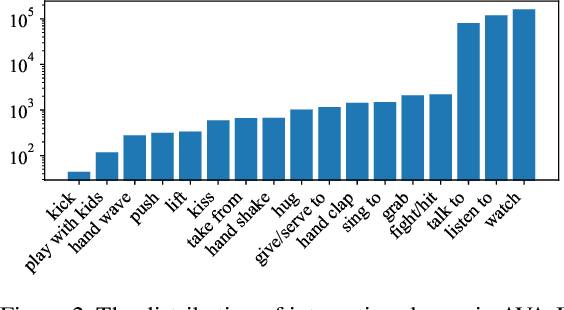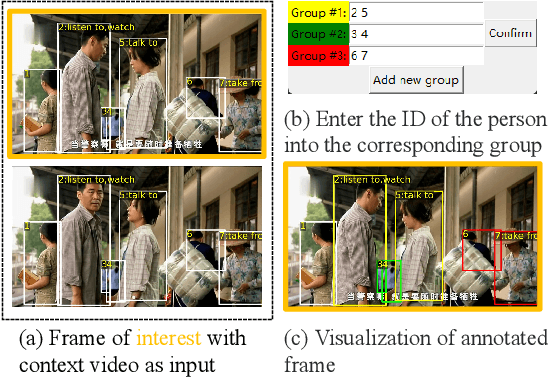Kaining Ying
MOSEv2: A More Challenging Dataset for Video Object Segmentation in Complex Scenes
Aug 07, 2025Abstract:Video object segmentation (VOS) aims to segment specified target objects throughout a video. Although state-of-the-art methods have achieved impressive performance (e.g., 90+% J&F) on existing benchmarks such as DAVIS and YouTube-VOS, these datasets primarily contain salient, dominant, and isolated objects, limiting their generalization to real-world scenarios. To advance VOS toward more realistic environments, coMplex video Object SEgmentation (MOSEv1) was introduced to facilitate VOS research in complex scenes. Building on the strengths and limitations of MOSEv1, we present MOSEv2, a significantly more challenging dataset designed to further advance VOS methods under real-world conditions. MOSEv2 consists of 5,024 videos and over 701,976 high-quality masks for 10,074 objects across 200 categories. Compared to its predecessor, MOSEv2 introduces significantly greater scene complexity, including more frequent object disappearance and reappearance, severe occlusions and crowding, smaller objects, as well as a range of new challenges such as adverse weather (e.g., rain, snow, fog), low-light scenes (e.g., nighttime, underwater), multi-shot sequences, camouflaged objects, non-physical targets (e.g., shadows, reflections), scenarios requiring external knowledge, etc. We benchmark 20 representative VOS methods under 5 different settings and observe consistent performance drops. For example, SAM2 drops from 76.4% on MOSEv1 to only 50.9% on MOSEv2. We further evaluate 9 video object tracking methods and find similar declines, demonstrating that MOSEv2 presents challenges across tasks. These results highlight that despite high accuracy on existing datasets, current VOS methods still struggle under real-world complexities. MOSEv2 is publicly available at https://MOSE.video.
Towards Omnimodal Expressions and Reasoning in Referring Audio-Visual Segmentation
Jul 30, 2025Abstract:Referring audio-visual segmentation (RAVS) has recently seen significant advancements, yet challenges remain in integrating multimodal information and deeply understanding and reasoning about audiovisual content. To extend the boundaries of RAVS and facilitate future research in this field, we propose Omnimodal Referring Audio-Visual Segmentation (OmniAVS), a new dataset containing 2,098 videos and 59,458 multimodal referring expressions. OmniAVS stands out with three key innovations: (1) 8 types of multimodal expressions that flexibly combine text, speech, sound, and visual cues; (2) an emphasis on understanding audio content beyond just detecting their presence; and (3) the inclusion of complex reasoning and world knowledge in expressions. Furthermore, we introduce Omnimodal Instructed Segmentation Assistant (OISA), to address the challenges of multimodal reasoning and fine-grained understanding of audiovisual content in OmniAVS. OISA uses MLLM to comprehend complex cues and perform reasoning-based segmentation. Extensive experiments show that OISA outperforms existing methods on OmniAVS and achieves competitive results on other related tasks.
MOVE: Motion-Guided Few-Shot Video Object Segmentation
Jul 29, 2025Abstract:This work addresses motion-guided few-shot video object segmentation (FSVOS), which aims to segment dynamic objects in videos based on a few annotated examples with the same motion patterns. Existing FSVOS datasets and methods typically focus on object categories, which are static attributes that ignore the rich temporal dynamics in videos, limiting their application in scenarios requiring motion understanding. To fill this gap, we introduce MOVE, a large-scale dataset specifically designed for motion-guided FSVOS. Based on MOVE, we comprehensively evaluate 6 state-of-the-art methods from 3 different related tasks across 2 experimental settings. Our results reveal that current methods struggle to address motion-guided FSVOS, prompting us to analyze the associated challenges and propose a baseline method, Decoupled Motion Appearance Network (DMA). Experiments demonstrate that our approach achieves superior performance in few shot motion understanding, establishing a solid foundation for future research in this direction.
MMT-Bench: A Comprehensive Multimodal Benchmark for Evaluating Large Vision-Language Models Towards Multitask AGI
Apr 24, 2024



Abstract:Large Vision-Language Models (LVLMs) show significant strides in general-purpose multimodal applications such as visual dialogue and embodied navigation. However, existing multimodal evaluation benchmarks cover a limited number of multimodal tasks testing rudimentary capabilities, falling short in tracking LVLM development. In this study, we present MMT-Bench, a comprehensive benchmark designed to assess LVLMs across massive multimodal tasks requiring expert knowledge and deliberate visual recognition, localization, reasoning, and planning. MMT-Bench comprises $31,325$ meticulously curated multi-choice visual questions from various multimodal scenarios such as vehicle driving and embodied navigation, covering $32$ core meta-tasks and $162$ subtasks in multimodal understanding. Due to its extensive task coverage, MMT-Bench enables the evaluation of LVLMs using a task map, facilitating the discovery of in- and out-of-domain tasks. Evaluation results involving $30$ LVLMs such as the proprietary GPT-4V, GeminiProVision, and open-sourced InternVL-Chat, underscore the significant challenges posed by MMT-Bench. We anticipate that MMT-Bench will inspire the community to develop next-generation multimodal foundation models aimed at achieving general-purpose multimodal intelligence.
CTVIS: Consistent Training for Online Video Instance Segmentation
Jul 24, 2023Abstract:The discrimination of instance embeddings plays a vital role in associating instances across time for online video instance segmentation (VIS). Instance embedding learning is directly supervised by the contrastive loss computed upon the contrastive items (CIs), which are sets of anchor/positive/negative embeddings. Recent online VIS methods leverage CIs sourced from one reference frame only, which we argue is insufficient for learning highly discriminative embeddings. Intuitively, a possible strategy to enhance CIs is replicating the inference phase during training. To this end, we propose a simple yet effective training strategy, called Consistent Training for Online VIS (CTVIS), which devotes to aligning the training and inference pipelines in terms of building CIs. Specifically, CTVIS constructs CIs by referring inference the momentum-averaged embedding and the memory bank storage mechanisms, and adding noise to the relevant embeddings. Such an extension allows a reliable comparison between embeddings of current instances and the stable representations of historical instances, thereby conferring an advantage in modeling VIS challenges such as occlusion, re-identification, and deformation. Empirically, CTVIS outstrips the SOTA VIS models by up to +5.0 points on three VIS benchmarks, including YTVIS19 (55.1% AP), YTVIS21 (50.1% AP) and OVIS (35.5% AP). Furthermore, we find that pseudo-videos transformed from images can train robust models surpassing fully-supervised ones.
Human-to-Human Interaction Detection
Jul 02, 2023



Abstract:A comprehensive understanding of interested human-to-human interactions in video streams, such as queuing, handshaking, fighting and chasing, is of immense importance to the surveillance of public security in regions like campuses, squares and parks. Different from conventional human interaction recognition, which uses choreographed videos as inputs, neglects concurrent interactive groups, and performs detection and recognition in separate stages, we introduce a new task named human-to-human interaction detection (HID). HID devotes to detecting subjects, recognizing person-wise actions, and grouping people according to their interactive relations, in one model. First, based on the popular AVA dataset created for action detection, we establish a new HID benchmark, termed AVA-Interaction (AVA-I), by adding annotations on interactive relations in a frame-by-frame manner. AVA-I consists of 85,254 frames and 86,338 interactive groups, and each image includes up to 4 concurrent interactive groups. Second, we present a novel baseline approach SaMFormer for HID, containing a visual feature extractor, a split stage which leverages a Transformer-based model to decode action instances and interactive groups, and a merging stage which reconstructs the relationship between instances and groups. All SaMFormer components are jointly trained in an end-to-end manner. Extensive experiments on AVA-I validate the superiority of SaMFormer over representative methods. The dataset and code will be made public to encourage more follow-up studies.
ISDA: Position-Aware Instance Segmentation with Deformable Attention
Feb 23, 2022



Abstract:Most instance segmentation models are not end-to-end trainable due to either the incorporation of proposal estimation (RPN) as a pre-processing or non-maximum suppression (NMS) as a post-processing. Here we propose a novel end-to-end instance segmentation method termed ISDA. It reshapes the task into predicting a set of object masks, which are generated via traditional convolution operation with learned position-aware kernels and features of objects. Such kernels and features are learned by leveraging a deformable attention network with multi-scale representation. Thanks to the introduced set-prediction mechanism, the proposed method is NMS-free. Empirically, ISDA outperforms Mask R-CNN (the strong baseline) by 2.6 points on MS-COCO, and achieves leading performance compared with recent models. Code will be available soon.
 Add to Chrome
Add to Chrome Add to Firefox
Add to Firefox Add to Edge
Add to Edge